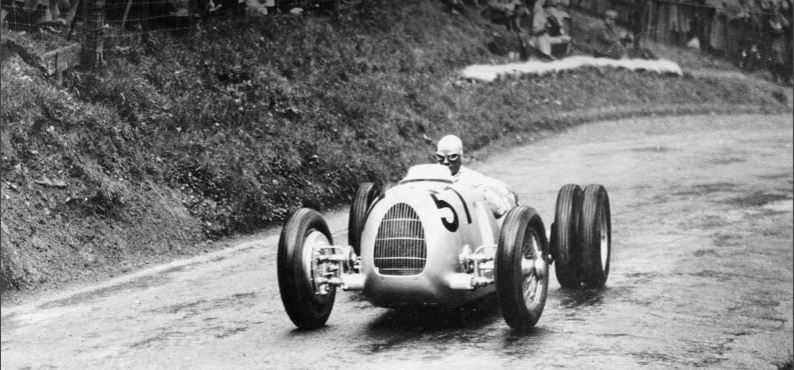King of the Hill !
Setting an overall best on the day of 45.2 seconds, Hans Stuck senior claimed victory in the ‘over 5 litres Supercharged class’, although his performance was hampered by wet weather that significantly slowed his attempts to improve on this.
A report following the weekend’s activities originally printed in Motor Sport Magazine in July 1936 (issue 337) described how Stuck senior was confronted with a ‘sharp shower of rain’ and had to battle ‘colossal wheelspin’ in an effort to launch the mighty mid-engined rear-wheeldrive v16 racing car off the line. on Stuck’s second attempt, Motor Sport recounted how he was ‘rewarded by the most ferocious series of tail wags we have ever witnessed, his elbows in turn rising high above the car’s side as he corrected the skids, and finished the run with a skid across the line which must have made the timing officials jump for their lives!’ in 1934, Auto Union, the forerunner of the modern Audi, began competing in Grand Prix racing, and along with its main rival Mercedes-Benz went on to dominate the series with cars that were soon to become known as ‘Silver Arrows’. it seems almost incredible today, but by 1936 the Auto Union racing cars were reaching speeds of over 235 mph on the long straights of the Avus circuit in Berlin.

By the end of 1937, Auto Union had competed in 54 races and won 32 – setting 15 world records in the process. The type C was the most successful German racing car of the era, having won three out of five Grand Prix by 1936 and half of all circuit and hill climb races that Auto Union entered. it was the third iteration of the brand’s Silver Arrow Grand Prix car, and by this stage its v16 engine had a displacement of 6.0 litres, producing a colossal 520 PS output with maximum torque of approximately 850 Nm at 2500 rpm. During the 1934 -1937 period, the basic design concept remained unchanged, with the v16-cylinder engine located in the centre of the chassis, behind the driver’s seat. Beneficial to both weight distribution and traction, this ‘mid-engined’ configuration continues to be used to this day by highperformance road-going supercars such as the Audi r8.
